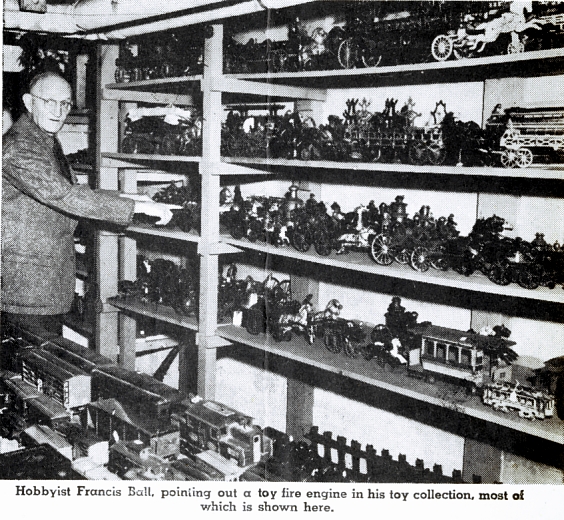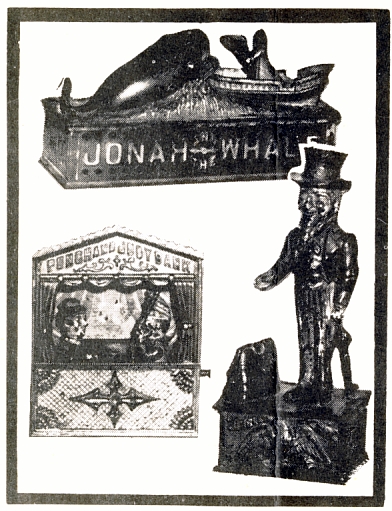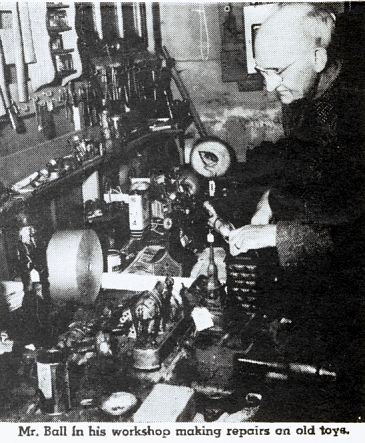| THE BOSTON SUNDAY POST MAGAZINE, March 29, 1953
He Never Grew Up
Cambridge Man at 70
Admits He’s Still a Kid in
Love With Toys - - - Has
Collection of Hundreds
By JAMES J. CANAVAN
 
Though many men of all ages have never outgrown
their love of toys, only a small minority will frankly admit it, and those
who glory in it, as does Francis L. Ball of Cambridge, are rare indeed.
At 70, Mr. Ball frankly
states that he gets greater thrill out of fooling around with toys today
than he ever did in his boyhood years. One reason for this is that now he
has hundreds of them, while as a youngster he had but a few.
For a number of years he
has spent the greater part of his spare time in attics, storerooms and
antique shops searching for toys which were popular not only when he was a
boy but in generations before he was born. The older the toys are that he
finds, the better he likes them, and if some are broken he takes pains to
repair them in his home workshop.
“You might say I never
grew up.” He chuckles, as he shows you a perfect replica of an old
horse-drawn fire engine. “Such toys as this bring back a host of thrilling
memories.”
His cellar, rambling and
spacious, looks like Santa’s shop with many shelves on each wall filled with
toys, some shiny and bright and others old, very old, but still proudly heat
and clean. Many of them are worn with the marks of care and affection.
The toys have given Mr.
Ball countless hours of enjoyment and no one realizes the great value of
them as does he. Each is marked and catalogued and every one has it’s proper
place. Since he retired five years ago from the presidency of the Malden Gas
and Electric Company, he has fondly inspected and fixed every item in his
collection.
One of the nation’s
experts on toys and their place in America’s history, Mr. Ball is always
willing to share his vast knowledge.
“Of course,” he says,
“I’ve spent a great deal of time with my toys but every moment of it has
been a happy one for me.
It is a fascinating hobby
for many reasons. First the history of toys is also the history of the
world, more or less.
TEACH HISTORY
“Every important event
that has occurred has been depicted at some time or another in toy form for
the amusement and education of children. Toys could be called, I imagine,
replicas in miniature of the manners and customs of a by-gone age.
“I know it seems hard to
realize, but youngsters were pulling small wheeled vehicles along behind
them as early as 1400 B. C.
“The established method
of manufacturing toys was not introduced until the later part of the 19th
century. Here in America toys were being made as early as 1843 as a business
enterprise. The famous J. & E. Stevens Company of Cromwell, Conn., was even
then making cap pistols and other toys.
Before that toy shops
flourished in large cities of the United States but their products were, on
the whole, imported from Germany, France and England.
“The first examples of
American toys were done in many cases by the village pewterer. Many of them
show that they were lovingly fashioned by hand in the home of the workshop.
“Prior to 1850 there was
no widespread distribution of toys in the United States. The earlier ones
were made with great care and thoughtfulness. They were first made from wood
then later reproduced in lead. This was so the edges and detail could be
sharpened, and then they were later fashioned in brass and bronze. Afterward
sand molds from these were taken and after this cast iron could be made into
working toys.”
KNOWS AGES
As soon as Mr. Ball sees
a toy made years ago he knows not only when it was manufactured but where it
came from. Each of his toys has some bit of American history tied up with
it. He claims the amazing part of the whole thing is how any collector can
have even one rare old toy because there are so many collectors in the
United States and each of them is constantly on the alert to secure the
most-wanted toys.
“American toys,” he
continued, “are one of the best documented portions of Americana. Each toy
has its special age and price. Naturally many of them, those that have
become very rare, are worth more than the other more-recent pieces.
“The new practice of many
to collect these various kinds of Americana is very heartening.. Soon the
toys of the past will be on public view, not only in museums, but in many
other places so that they’ll always be available for people to see.
“After the toy-making
industry started in this country some toys had movements added by joints and
levers, which not only brought a few dollars more, but also started a new
era. Things like locomotives, that actually ran by steam, were even then
becoming popular.
“As the years passed toys
changed. Circus wagons were perennial, but these like all horse-drawn
vehicles, began about 1900, to be followed by automobiles and trucks. The
first action toys they had, had a strange fascination for boys that has
never decreased. The toys were gifted with action and life to amuse young
and old. They produced astonishment and wonder. They were an American
heritage.
“All early American-made
toys showed a fine craftsmanship and improvements made it possible to add
movement and sound and so increase fascination for children.
Mr. Ball spends many of
his nights answering questions about toys. The mailman is always bringing
letters from all over the country from people seeking information from him.
Although he’s busy he finds time to answer all letters about toys. He
especially likes to answer men asking about toys they had when they were
young. The letters he gets are always filled with memories of the happy days
of the past.
“There’s a lot of
happiness associated with toys,” he added. “Perhaps that’s why it holds such
a fascination for me. Once you’re in it it’s hard to get out. I know.
|